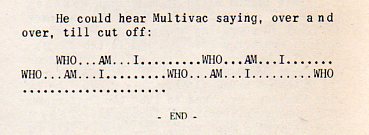JF PTak Science Books Post 1375
Following up on yesterday's post on the world's first (popularly-published) computer magazine (Computers and Automation) is this Isaac Asimov short story on what might be the first great computer question. The story in mind, "Question", appeared in the March 1955 issue of this same magazine, a two-pager sandwiched between an ad for Remington Rand UNIVAC and an article on computers and weather prediction. It is the first appearance too of Asimov's massive computer of the future, Multivac, a giant machine with corridors and nooks where technicians could stop and have a seat to enjoy a cup of coffee. And it seemed to at least one worker that it wasn't quite right to be sitting inside the machine, that the billion-tube, two billion relay computer was more than just a flow of electrons. (The ENIAC, which was basically the world's first computer, had 20,000+ tubes, so a billion as conceived by Asimov would've been a very big machine indeed, a 500,000-ENIACs-sized behemoth.) And a very hot one. The workers wondered if you could ever tell if the machine was alive, if it thought on its own, if it attacked aparat from its instructions and programs.
As it turns out, the answer was positive, and not only that, but Multivac could speak. Its answer to "the question" was "who...am...I...?", repeated several times in the closing sentence of this rocket-fast short story. I guess that that would give you pause, as it would anyone had the question come to them from their own computer while communicating along the spine of the great global "mind", the Internet, and perhaps someday it will, at some time in the near-ish future when the height of our own computer-y heights looks as quaint to them as a half-million ENIAC idea of 1955's premier scifi writer looks to us today.
I know almost nothing about Asimov, but he seems to return to this idea of the Big Computer, Multivac, and ultimate question a few years later. It seems as though there was an issue of serendipity involve with the structure of the "Question" story and that of another writer's ending for a story called "Problem for Emmy" by Robert Sherman Townes. Asimov admitted the similarities but also maintained that he didn't know of Townes and had never read his story--be that as it may, Asimov promised that he would never reprint the story, and it seems as though he never did. But it looks as though he resurrected his idea somewhat, which is fine, because the whole idea of ultimate/penultimate questions and massive computers is a great genre.
Asimov wrote a story called "The Last Question" in 1956, a year later, writing about a trillion years of human history in the space of another terrifically-short short story, the short story that Asimov found to be his own favorite. If "Question" posted the ultimate question put to the super-colossal Multivac computer, ultimate question in "The Last Question" may well then be the ultimate answer. You'll have to see the ending of the story for yourself to see what it was--I can't spoil it.
Notes:
1. I'm just a little surprised that Asimov was hung up on tubes in 1953--transistors had been in the air by 1947/8, published in 1948, and pretty-published by 1952. I figure he should've been aware of them and how they would transform computer construction. Maybe not. Perhaps he just wanted to write about a billion-tube computer. "Multivac " stands for "muliple vacuum tubes", and then "multiple vacuum tubes analog computer", so using transistors might be a little at cross-odds with the name and the idea of the machine. It woulod be interesting to put together a list of questions/answers of these early fictional machines, a longlist of which appears here.
2. The two characters in the story by the way are named "Alexander Adell and Bertram Lupov", both of which suggest the name Alexander Graham Bell to my head.




Comments